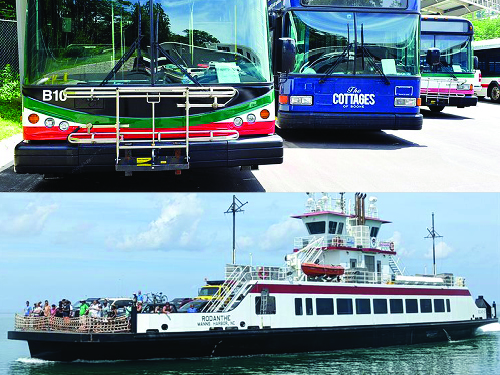The North Carolina Department of Transportation recently introduced two new mobility resources: A new web page devoted to on-demand “microtransit,” a public transportation service that takes riders to and from preferred destinations, and a new text and email notification system to alert passengers when weather or mechanical issues cause schedule interruptions on state ferry routes.
[Above photo by NCDOT]
“On-demand microtransit services provide improved mobility and access to opportunities,” noted Ryan Brumfield, director of NCDOT’s integrated mobility division in a statement. “It also allows the state to meet the needs of citizens more effectively by providing multimodal services that are comparable to driving in terms of time, convenience, and cost.”
Such on-demand microtransit services offer riders access to a public transportation option that is flexible and responsive to real-time needs, the convenience of booking and paying online, and improved access to essential services such as school and medical appointments, he explained.
That service is targeted to help people who live in rural and underserved communities without reliable transportation. State officials estimate that as many as 1 million people do not have reliable transportation service. “This ability to use transit for spontaneous trips similar to driving is fundamental to providing equitable mobility to everyone,” Brumfield noted.
In 2022, NCDOT and the Institute for Transportation Research and Education and Department of Civil, Construction, and Environmental Engineering at N.C. State University compiled a report examining the success of microtransit pilot programs as well as exploring the challenges they face to plan in order to implement microtransit options.
The findings from that report – entitled “Public Microtransit Pilots in the State of North Carolina” – focused on solving challenges such as lack of available and sustainable funding for microtransit programs, meeting the demand for service and Americans with Disabilities Act or ADA compliance, difficulties scheduling trips on a mobile app instead of by phone call and accessing virtual transit stops not designated by physical infrastructure like shelters, benches and signs.
Meanwhile, NCDOT’s new Ferry Information Notification System, or FINS, will allow passengers to not only select the routes they want to receive alerts from, and choose whether to receive those alerts via text, email or both, they’ll receive those alerts directly from ferry terminals when a departure is delayed or canceled, or when service resumes after a service suspension.
“This is going to be a major benefit for our passengers,” said NCDOT Ferry Division Director Harold Thomas in a separate statement. “Getting timely information on schedule interruptions will allow ferry riders to make informed decisions on when and where to travel.”
For several years, NCDOT’s Ferry Division has used route-specific Twitter accounts to announce schedule interruptions, but users have stated a preference for having those notifications sent directly to them. The Ferry Division will continue to send out notifications via Twitter while users transition to the new FINS system.
 States
States
NCDOT Staff Participate in ‘Explosive’ Technical Training
December 19, 2025 States
States

